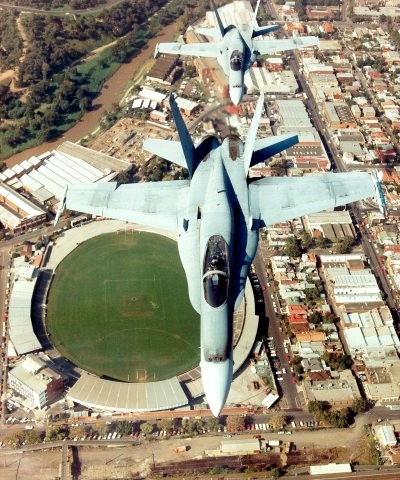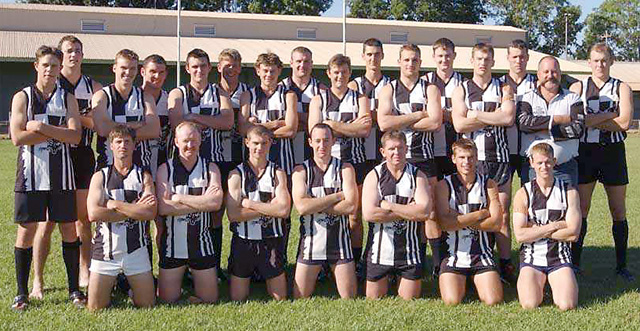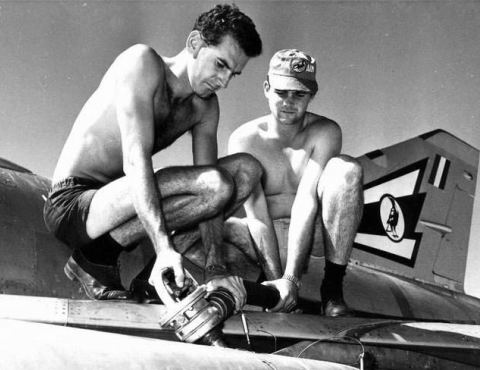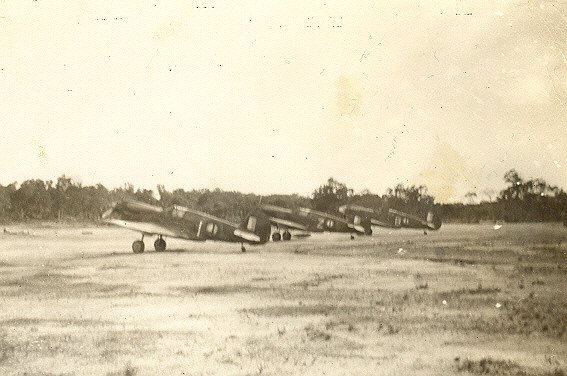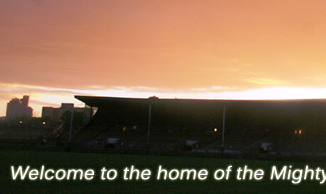
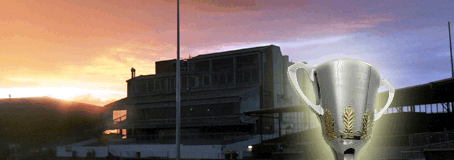
 |
||||||||||||||||||||||||||||||||||||||||||
|
|
||||||||||||||||||||||||||||||||||||||||||
|
Formed in Townsville, QLD on March 4th of 1942, 75 Squadron is one of WWII's most famous flying units. Back then they flew the magestic US built Kittyhawk, but today they are equiped with supersonic FA18 Hornets. Here we will touch on some of the history of the striking Magpies of the air and below you can see an extroadinary photograph taken by one the 75 Squadron crew as they flew over Victoria Park some time in 1989. I will start with a special thank you to John Graham for his copy of the photo and detailed background information that has formed the basis of this page.
Pictured above are two RAAF Hornets from 75 Squadron based at Tindal N.T. flying over Victoria Park as part of an Aaustralian tour just after the squadron took delivery of the aircraft in 1988. The Squadron crest for 75 Squadron is the same proud Magpie that has featured on the CFC crest for many decades, and there has been a loose connection for many years between 75 Squadron and the Collingwood Football Club. In the Brian Hansen centenary history book there are two photos of players with the aircraft taken at RAAF Base Williams, Laverton in Victoria. On p303, Paul Tuddenham and Craig Kelly are shown with the lead aircraft's pilot, SQNLDR Ross Fox, with the Magpie painted on the aircraft (the caption incorrectly identifies the aircraft as Vampires). On p319, there is a photo of Shane Kerrison in the pilot’s seat. Tragically, SQNLDR Fox, then promoted to Wing Commander, was later killed in a mid air collision with another Hornet. WGCDR Fox passed away on the 4th of August 1990, just 2 months before Collingwood's famous drought breaking premiership win. Two coincidences were involved in that accident, the first was that the aircraft crashed 35 km from Katherine on a place known as Hornet Hill. The other coincidence that resonated deeply with Magpie fans is that the crashed aircraft's serial number was A21-42. All hornets are in the A21 series, but given the Darren Millane tragedy just over a year later, the fact that it was serial number 42 is quite eerie.
The Tindal Magpies The RAAF Base at Tindal had a football team in the local Katherine league and played in the Black and White jumper as the “Tindal Magpies”
The history of 75 Squadron Formed in Queensland in March 1942, 75 Squadron was to become one of the RAAF's most famous units. Equipped with American-built Kittyhawk fighters, and with only one weeks training, the Squadron flew to New Guinea. After this most successful beginning, 75 Squadron went on to extract a heavy toll on the Japanese. Continuous combat took its toll on both men and machine and after six weeks of fighting, a battle weary 75 Squadron - with just one serviceable Kittyhawk left - was relieved and returned to Australia. During its first forty four days of combat, 75 Squadron destroyed thirty four enemy aircraft and damaged a further forty four. Sadly, the Squadrons heroic defence of Port Moresby did come at a terrible price - twelve pilots were killed and many more wounded. A replenished 75 Squadron returned to New Guinea in August and joined with 76 Squadron in the defence of Milne Bay. Soon after their arrival, a Japanese invasion force steaming towards Milne Bay came under attack from Squadron Kittyhawks modified to carry bombs. Although a number of ships were damaged, the Japanese convoy sailed into Milne Bay on the 24 August, disembarking their troops before dawn. At first light, the Kittyhawks began shuttle attacks against landing barges, stores and troops. Despite torrential rain and appalling conditions ground personnel worked tirelessly to refuel and rearmed the Kittyhawks. Although Australian ground forces were contesting every yard, the enemy was soon so close, the Kittyhawks guns were firing before their undercarriages had retracted. Gradually the Australians gained the upperhand and when it became apparent to the Japanese that the battle was lost, Japanese ships under the relative protection of darkness, entered Milne Bay and embarked what troops and equipment they could. After playing its part in the first defeat of Japanese ground forces in the Pacific War, 75 Squadron - operating from a succession of bases - continued to attack Japanese garrisons for the duration of the war. The squadrons first permanent deployment after the war, saw 75 squadron personnel, operating RAF Vampire jet fighters, in defence of the Mediterranean island of Malta. After the squadron's return to Australia in 1955, the Vampires were soon replaced by the highly manoeuvable Sabre. This popular aircraft was in turn replaced by the supersonic Mirage in August 1965. In 1967, 75 squadron deployed to Malaysia and after sixteen years in Butterworth, returned to Australia. By 1988 the squadron had moved to its present location at Tindal in the Northern Territory, and from here it continues to operate the multi-role F-18 Hornets in the defence of northern Australia.
Further reading: If anyone has any information regarding 75 Squadron that they would like to share please email us at info@victoriapark.net.au |
|
|
|
|
| Site Map |
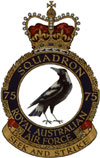 75 Squadron RAAF
75 Squadron RAAF